- Typology
- Community
- Project
- Park Platz @ Berlinische Galerie XXX
- year
- 2021
- Location
- Berlinische Galerie - Landesmuseum für moderne Kunst, Fotografie und Architektur, Friedrichshain-Kreuzberg, Berlin, Deutschland
- The pavilion designed by c/o now for "Park Platz" does not only aim to respond to the changed conditions of cultural gatherings due to the pandemic, but also attempts to think differently about the typological as well as social threshold space between museums as institutions and the city. Spaces should be staged rather than defined. The specific aesthetics of the site and the readymade components deriving from industrial production are to be accepted and placed on an equal footing with process-based architectural, artistic and social design processes.
- project lead
- Nuno De Brito Rocha (Berlinische Galerie)
- team c/o now
- Tobias Hönig, Andrijana Ivanda, Markus Rampl, Paul Reinhardt, Duy An Tran
- structural engineering
- Kerstin Borowszak, Andreas Schulz (Pichler Ingenieure)
- metal construction
- Thein & Rios
- participants
- Atelier Bunter Jakob, Bilgisaray, c/o now, Zuzanna Czebatul, Kunstwerkstatt Kreuzberg der Lebenshilfe Berlin e.V., Daniel Lie, Hanne Lippard, Mpower, Ania Nowak, Lucas Odahara, poligonal, Przemek Pyszczek, Liz Rosenfeld, Marinella Senatore, Raul Walch
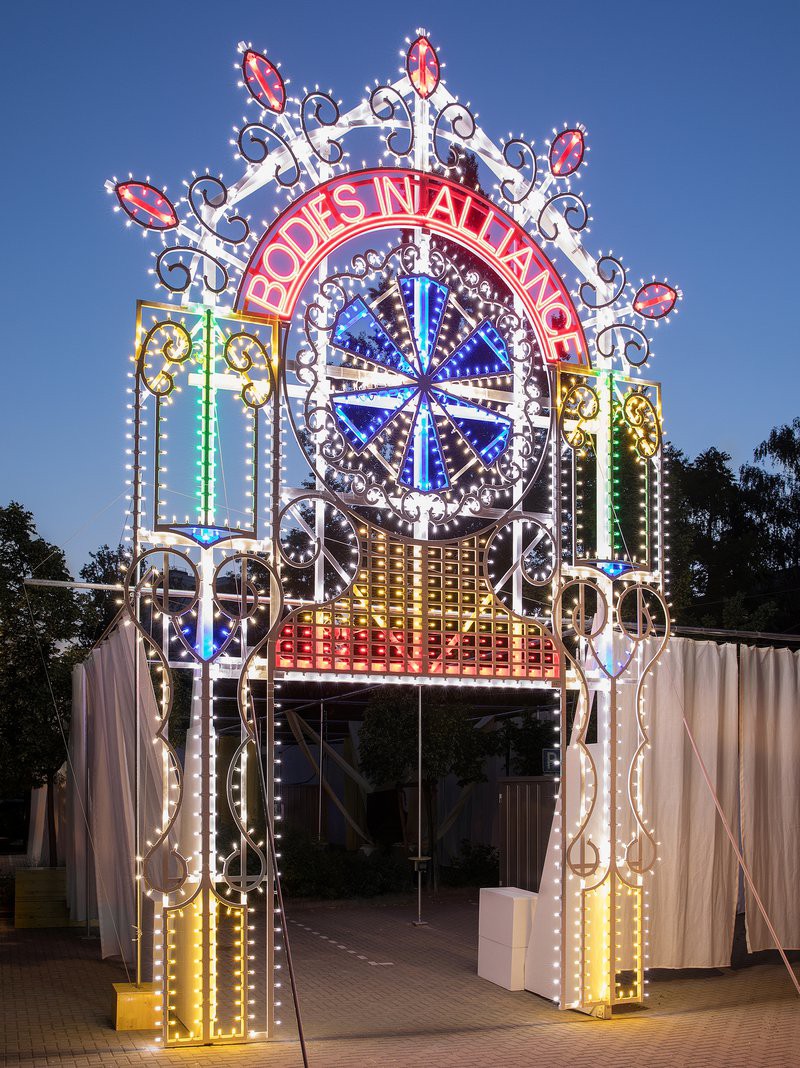 XXX
XXX
Fig.___Marinella Senatore, Bodies in Alliance, 2021
© Sandy Volz
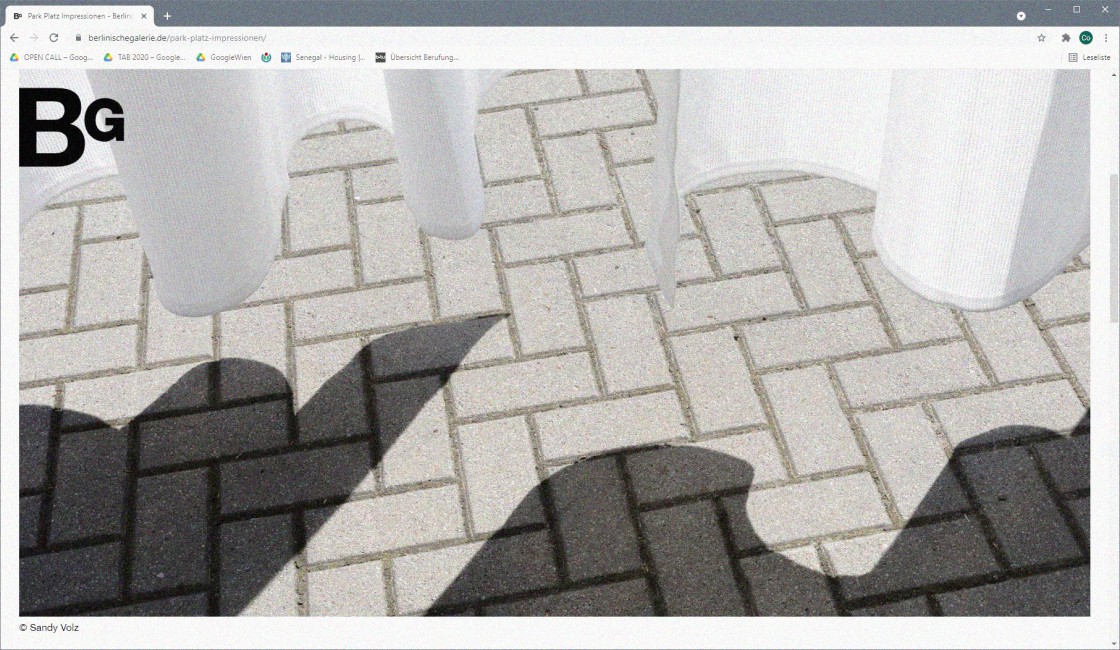 XXX
XXX
Fig.___© Sandy Volz
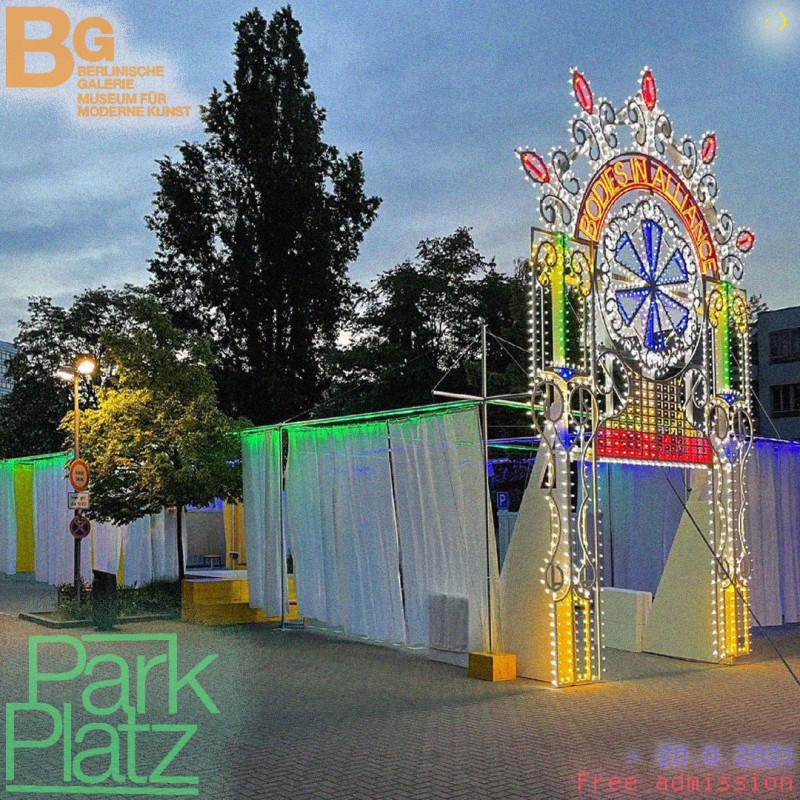 XXX
XXX
Fig.___Photography: Nuno De Brito Rocha
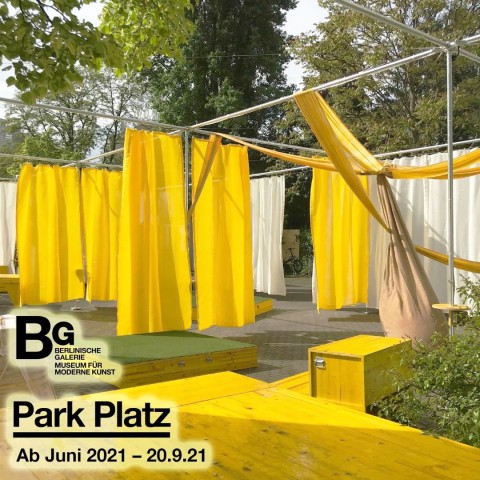 XXX
XXX
Fig.___© c/o now
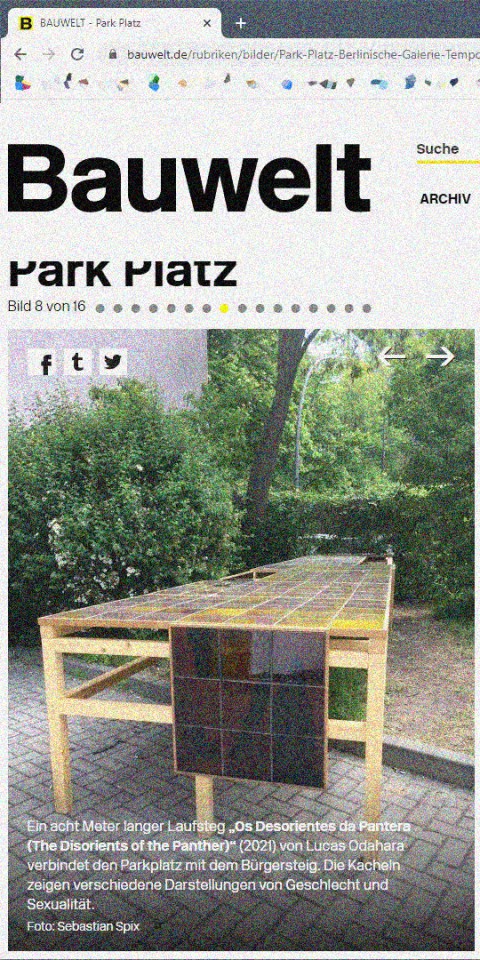 XXX
XXX
Fig.___Lucas Odahara
Work on display: “Os Desorientes da Pantera (The Disorients of the Panther)” (2021)
Lucas Odahara’s eight-metre-long catwalk of painted ceramic tiles links the car park to the pavement on the street. The tiles show various depictions of gender and sexuality. They were inspired by the “Baile Pantera Gay” (Gay Panther Ball)—a series of events held between 1986 and 1989 in the north-west of Brazil (Rio Branco). Hunting scenes drawn from historical paintings and newspaper reports broaden the thematic spectrum to include violent displacement, the plundering of natural resources and conventional views of the “exotic”.
Biography
Lucas Odahara (*1989 São Paulo, Brazil) studied Product Design at the State University of São Paulo, then Digital Media and Fine Arts at the University of the Arts (HFK) in Bremen. His work has been seen at many exhibitions, including: Kunstverein Grafschaft Bentheim (2020); Indus Valley School of Art and Architecture, Karachi, Pakistan (2019); Schwules Museum, Berlin (2017); NUDA magazine, Stockholm (2017); Kunsthal Charlottenborg, Copenhagen (2016); Weserburg Bremen (2015) and Künstlerhaus Bremen (2015). He has been a DAAD scholar and in 2019 he won the Urban Design Prize awarded by the Senator for Culture in Bremen. He lives in Berlin.
© Bauwelt Online
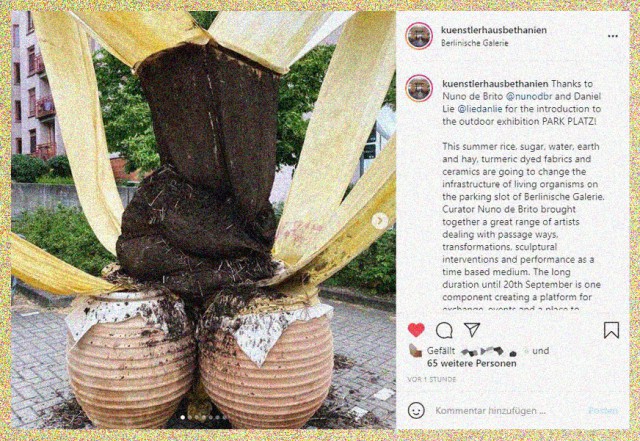 XXX
XXX
Fig.___Daniel Lie
Work on display: “Sopro (Sigh)” (2021)
Daniel Lie’s works have a life of their own: natural, non-industrial materials, plants and fungi are carefully combined in organic compositions. They celebrate primary substances that decompose by themselves, examining the renewal of ecosystems and biological cycles of decay. These site-specific installations speak of processes in which time and the metamorphosis of untreated matter are the principal agents.
Biography
Daniel Lie (*1988 São Paulo, Brazil) is a non-binary Indonesian-Brazilian artist. Lie studied Fine Arts at the University of São Paulo and was a scholar at the Indonesia Institute of The Arts, Yogyakarta (2020), the Sharjah Art Foundation (2019) and Teresina Tohoku, Campo Teresina/Brazil. Lie has had solo exhibitions at the Cemeti Institute for Art and Society, Yogyakarta/Indonesia (2020); Casa do Povo, São Paulo (2019); Jupiter Art Land, Edinburgh (2020); Performeum/Vienna Festwochen, Vienna (2017); Change, Budapest (2016); Kampnagel, Hamburg (2016) and Centro Cultural São Paulo, São Paulo (2015). Works by Daniel Lie have featured at many group exhibitions, including in Solar dos Abacaxis, Rio de Janeiro (2020); Galeria Prego, Porto Alegre (2019); Sesc Belenzinho, São Paulo (2018); Bouge B Festival, Antwerp (2018); Osage Foundation, Hong Kong (2018); 14th Yogyakarta Biennale (2017); Q21, Vienna (2017); Hellerau, Dresden (2016); Espacios Revelados, Santiago/Chile (2016) and Instituto Tomie Ohtake, São Paulo (2014). Daniel Lie lives and works in Berlin.
---
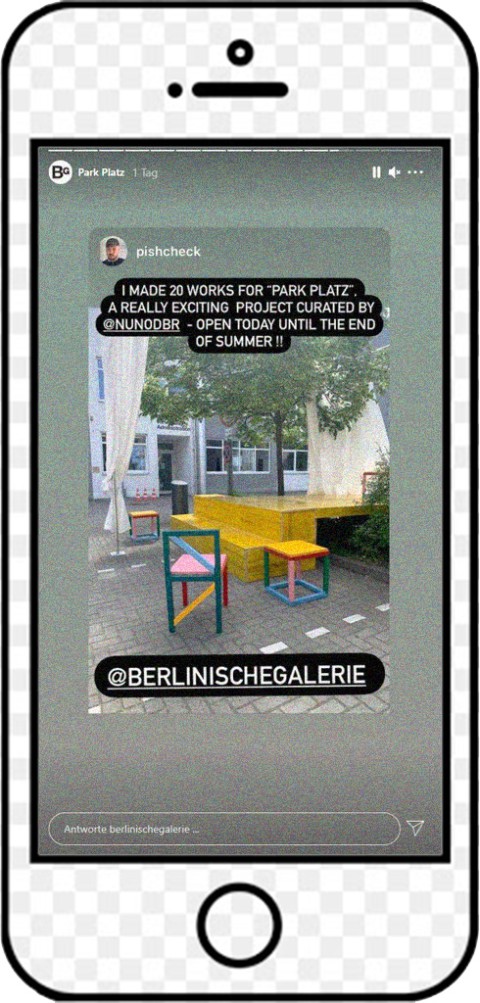 XXX
XXX
Fig.___Przemek Pyszczek
Work on display: “Not My Circus, Not My Monkeys” (2021)
Art and utensils combine here in the works presented by Przemek Pyszczek. Benches, chairs and stools are important features of public life. Pyszczek’s furniture made of metal and wood is inspired by structures in the public space and by social thinking in post-communist Poland: concrete housing estates, fences and playgrounds derived from socialist mass production, but also adornments for façades, colours, ornamentation and graphic structures.
Przemek Pyszczek (*1985 Bialystok, Poland) studied Environmental Design (Architecture) at the University of Manitoba, Winnipeg/Canada. He has had solo exhibitions at: Last Resort, Copenhagen (2020); Galerie Derouillon, Hôtel Cromot du Bourg, Paris (2019); Galerie Belenius, Stockholm (2019); Leto Gallery, Warsaw (2019); Plug In Institute of Contemporary Art, Winnipeg (2018); High Gallery, Poznań/Poland (2017) and Nicodim Gallery, Los Angeles (2016). Pyszczek has participated in a number of group exhibitions, including at: Manana Bold, Frankfurt (2020); Ribot Gallery, Milan (2020); Contemporary Art Biennial, Coimbra/Portugal (2019); public art festival, Gdańsk (2019); Haus am Lützowplatz, Berlin (2018); Museo Archeologico e d’Arte della Maremma, Grosseto/Italy (2018); NGBK, Berlin (2016) and Office Baroque, Brussels (2015). Przemek Pyszczek lives and works in Poland and Berlin.
---
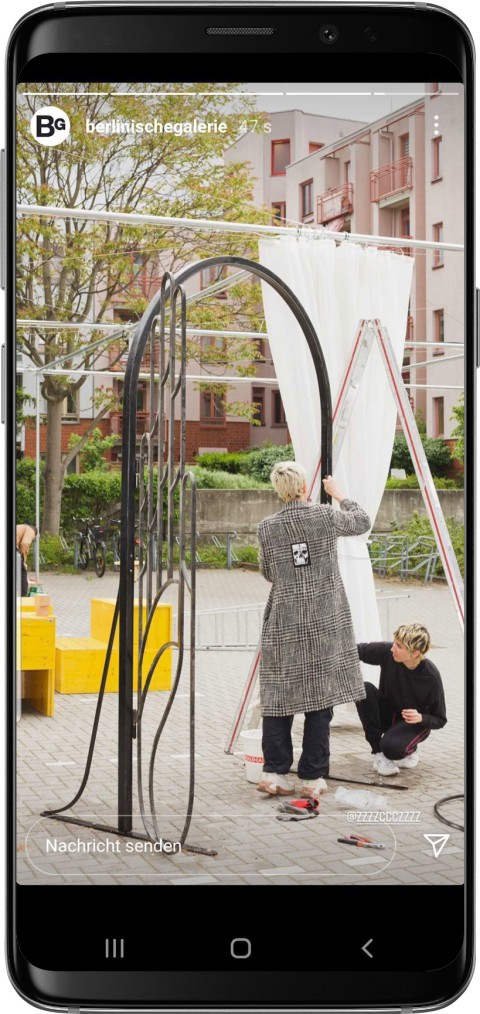 XXX
XXX
Fig.___Zuzanna Czebatul
Works on display: “Within Meadows And Rolling Hills” (2016) and “Psy Away” (2019)
Architecture is a central theme in sculptural art by Zuzanna Czebatul. Her work explores it as a language and symbol of power in the public space. Her objects elicit a sense of distance and yet suggest immediacy: these gates, for example, create both access and a barrier. They reference a city closed off by rules and boundaries. Or else we can simply walk around them.
Zuzanna Czebatul (*1986 Miedzyrzecz, Poland) studied at the Städelschule in Frankfurt/Main and was a Fulbright scholar at Hunter College, New York, and a SOMA scholar in Mexico City. Venues creating solo exhibitions for Czebatul’s work include: Kunstpalais Erlangen (2021); EXILE Gallery, Vienna (2021); Owned by Others, Berlin (2020); IG Metall Haus, Berlin (2019); Futura, Prague (2018) and MINI/Goethe-Institut Ludlow 38, New York (2015). She has recently participated in group shows at: Museum Morsbroich, Leverkusen (2021); Athens Biennale (2021); Wrocław Biennale (2021); Kunsthalle Bratislava (2020); Trafo, Szczecin (2020) and Somerset House, London (2019). Czebatul lives and works in Berlin.
---
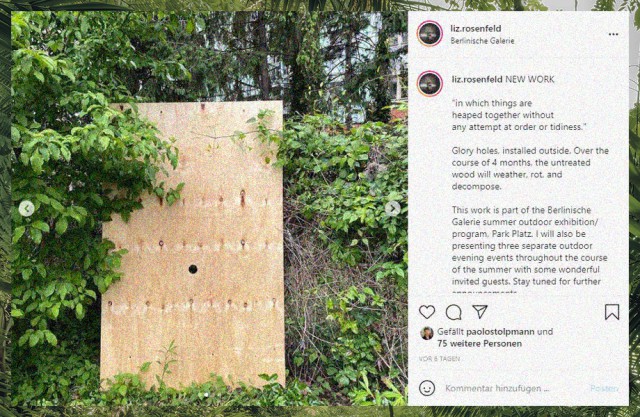 XXX
XXX
Fig.___Liz Rosenfeld
Work on display: “in which things are heaped together without any attempt at order or tidiness” (2021)
Liz Rosenfeld’s contribution is a reflection on cruising. Cruising means going out into public places to look for anonymous sex and the practice has evolved out of a primarily cis-male, homosexual history. Apart from her sculptural “glory hole” intervention in the car park, Rosenfeld will host one to three evening discussions and performative events about the public space as a setting for desire.
Liz Rosenfeld (*1979 New York, USA) is a film-maker and performer who works with moving images, performance and education. Liz Rosenfeld studied New Media and Fine Arts at the School of the Art Institute of Chicago and Performance Studies at Tisch School of the Arts at New York University. Venues to have shown Rosenfeld’s work include: Sophiensæle, Berlin; Hebbel am Ufer Theater, Berlin; Mapa Teatro, Bogotá; Tate Modern, London; Hayward Gallery, London; Kunst Haus, Dresden; Victoria & Albert Museum, London and The Hammer Museum, Los Angeles. She has worked in education for institutions such as the School of the Art Institute of Chicago, the Royal Central School of Speech and Drama and South Bank University in London, the Film University in Babelsberg and the Academy of Fine Arts (HfBK) in Dresden. Rosenfeld belongs to the Berlin-based film production collective NowMomentNow and is a founding member of the food performance group FoodGASM. Liz Rosenfeld lives in Berlin.
---
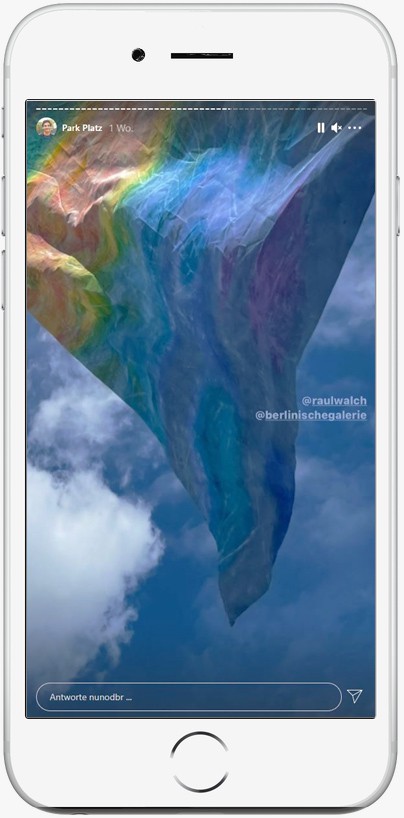 XXX
XXX
Fig.___Raul Walch
Work on display: “The Three Trees” (2021)
The artistic practice of Raul Walch combines recent urban debates with participation. His works are ephemera that explore the potential of public space. At the same time, he negotiates new strategies for its enhancement. For “Park Platz” the artist has replaced the three Berlinische Galerie flags outside the museum with painted fabric. Over the summer he will also develop a work with local residents and take part in the workshop series “Sundays in the Park”.
Raul Walch (*1980 Frankfurt/Main, Germany) studied Sociology and Latin American Studies at FU Berlin, Sculpture at the Kunsthochschule in Weissensee and Fine Arts with Olafur Eliasson at UdK Berlin. Walch teaches Art in Public Space and New Artistic Strategy at the Bauhaus University in Weimar. He has taken part in numerous exhibitions, including at the following institutions: Museum der Bildenden Künste, Leipzig (2020); Centre Culturel Régional, Tambacounda, Senegal (2020); Kunsthaus Dresden (2018); Hamburger Bahnhof, Berlin (2017); Kunstverein Arnsberg (2017) and Neue Nationalgalerie, Berlin (2014). He has been artist-in-residence at the Tokyo Arts and Space and the Nida Art Colony in Lithuania. Raul Walch lives in Berlin.
---
- XXX
Gif.___Park Platz is accompanied on behalf of Berlinische Galerie in social media by the graphic studio Otto Sauhaus (Sarah Lamparter & Nastia Protsenko) and the photographer Kaja Strempel...
© Otto Sauhaus 4 Berlinische Galerie
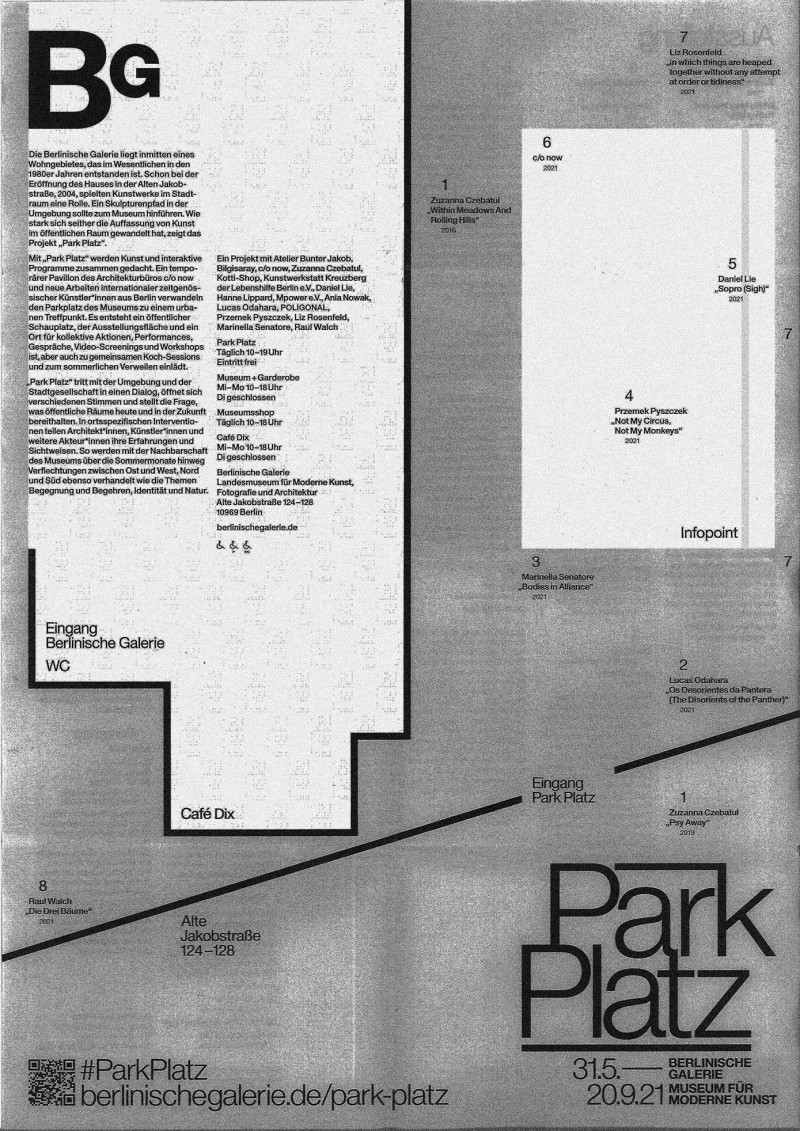 XXX
XXX
Fig.___The Berlinische Galerie stands in the middle of a residential neighbourhood built mostly in the 1980s. Ever since the museum opened on Alte Jakobstrasse in 2004, art for the urban space has had a role to play. Back then, a sculptural pathway was designed to lead through the area to the entrance. Just how much attitudes to art in the public space have changed since then is illustrated by the “Park Platz” project.
The concept for “Park Platz” combines art with interactive events. A temporary pavilion by architects c/o now and new works by Berlin-based contemporary artists from many different countries will transform the museum car park into an urban forum. A public theatre is emerging with an exhibition area and space for collective action, performance, debate, video screening and workshops, but also for cooking together and relaxing on a summer’s day.
“Park Platz” sets up a dialogue with its surroundings and with urban society, opening up to diverse voices and asking what public spaces can contribute to our lives today and tomorrow. There will be site-specific interventions where architects, artists and others reflect their experience and perspectives. Throughout the summer months, these activities will engage with the museum’s neighbours to address connections between east and west, north and south, and themes such as encounter and desire, identity and nature.
A project with Atelier Bunter Jakob, Bilgisaray, c/o now, Zuzanna Czebatul, Kotti-Shop, Kunstwerkstatt Kreuzberg der Lebenshilfe Berlin e.V., Daniel Lie, Hanne Lippard, Mpower e.V., Ania Nowak, Lucas Odahara, POLIGONAL, Przemek Pyszczek, Liz Rosenfeld, Marinella Senatore, Raul Walch
“Park Platz” is a “Draussenstadt” project funded by the Federal State of Berlin.
© Berlinische Galerie, Landesmuseum für moderne Kunst, Fotografie und Architektur
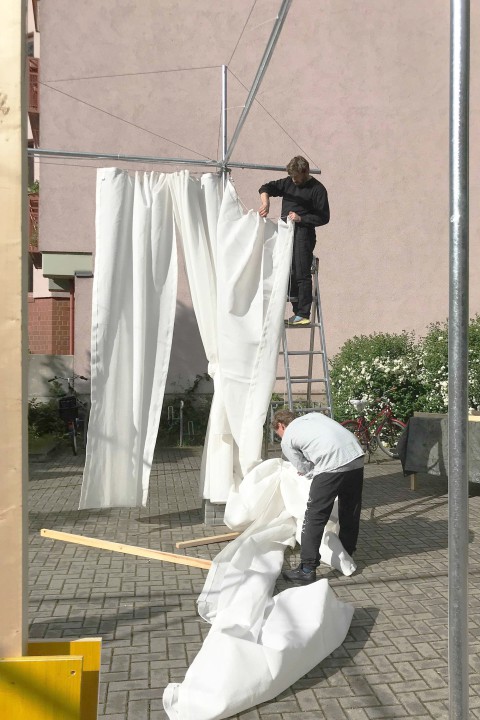 XXX
XXX
Fig.___© c/o now
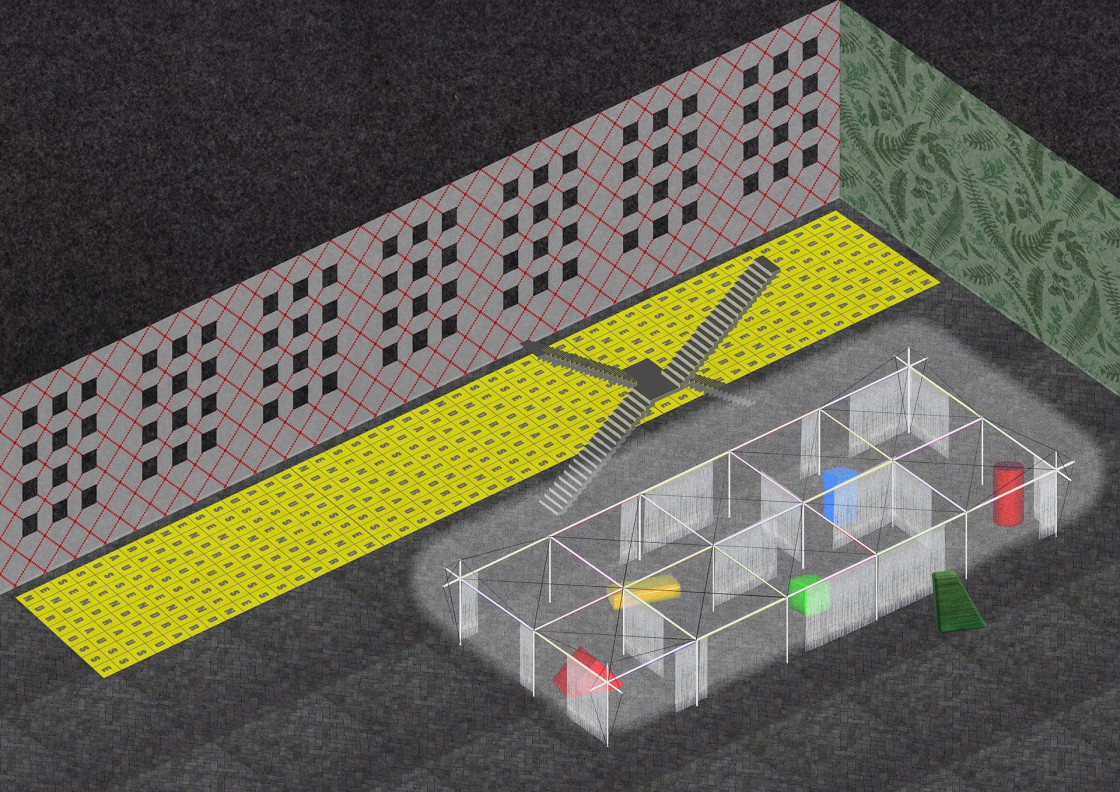 XXX
XXX
Fig.___© c/o now
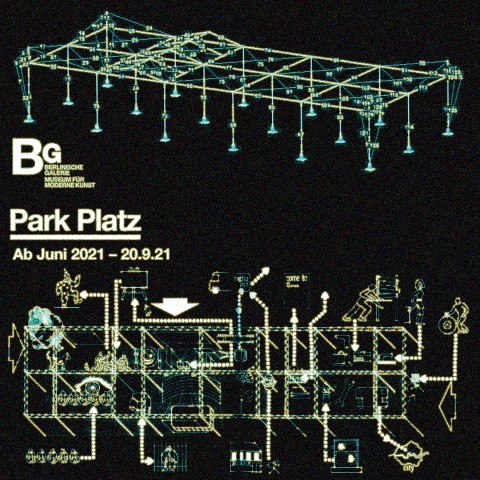 XXX
XXX
Fig.___© c/o now
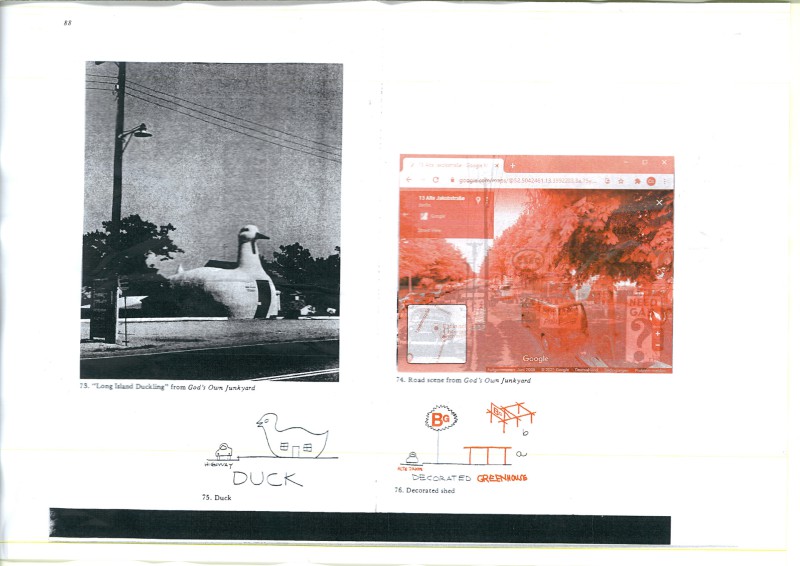 XXX
XXX
Fig.___© c/o now
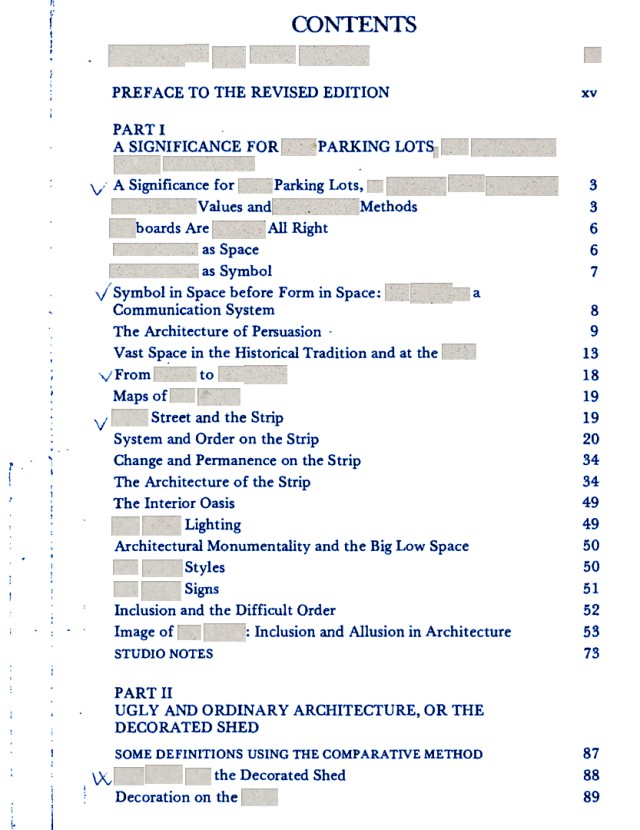 XXX
XXX
Fig.___© c/o now
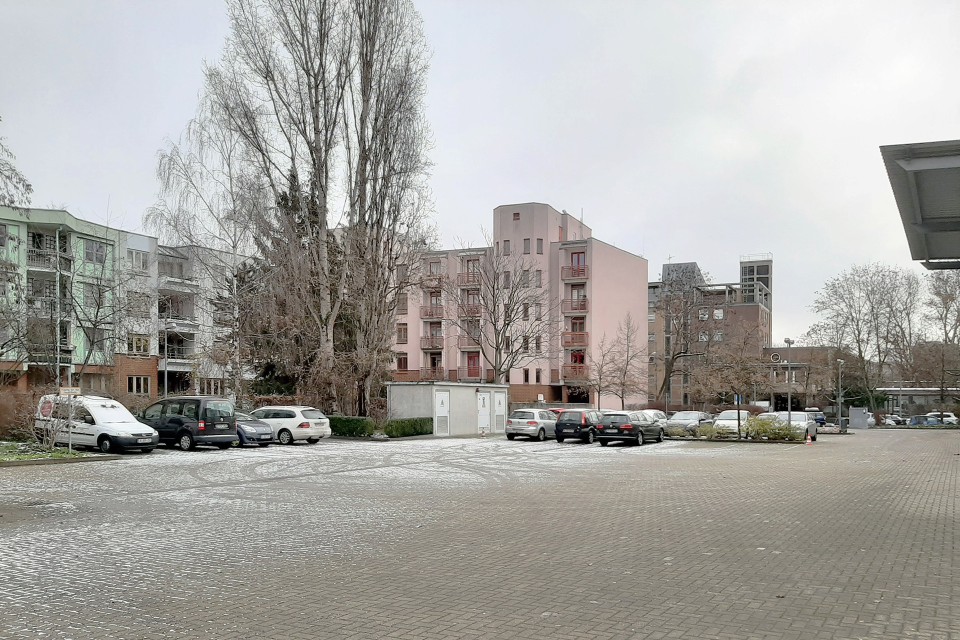 XXX
XXX
Fig.___Located on the north side of the Berlinische Galerie, the site is framed to the north by residential buildings by Planungskollektiv 1, Gruppe 67 and Rob Krier. To the east, the former main children's home planned by Max Taut and completed by Frank Bornemann, with an open space plan by Hermann Mattern, defines the space to be played.
© c/o now